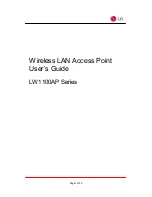
Page 8 of 50
for the wireless network, aggregating access for multiple wireless stations onto the wired
network. Wireless end stations can be 802.11 PC Card, PCI.
¦
Wireless LAN Network Configuration
The 802.11 standard define two modes:
infrastructure
mode and
ad hoc
mode (or
independent or peer-to-peer).
l
Ad Hoc Mode
Ad hoc mode (also called peer-to-peer mode or an Independent Basic
Service Set, or IBSS) is simply a set of 802.11 wireless stations that
communicate directly with one another without using an access point or any
connection to a wired network. This mode is useful for quickly and easily
setting up a wireless network anywhere that a wireless infrastructure does not
exist or is not required for services, such as a hotel room, convention center,
or airport, or where access to the wired network is barred (such as for
consultants at a client site).
Figure 1. Ad Hoc Mode
l
Infrastructure Mode
In infrastructure mode, the wireless network consists of at least one access
point connected to the wired network infrastructure and a set of wireless end
stations. This configuration is called a
Basic Service Set (BSS
). An
Extended
Service Set (ESS)
is a set of two or more BSSs forming a single sub-network.
Independent Basic
Service Set (IBSS)









































